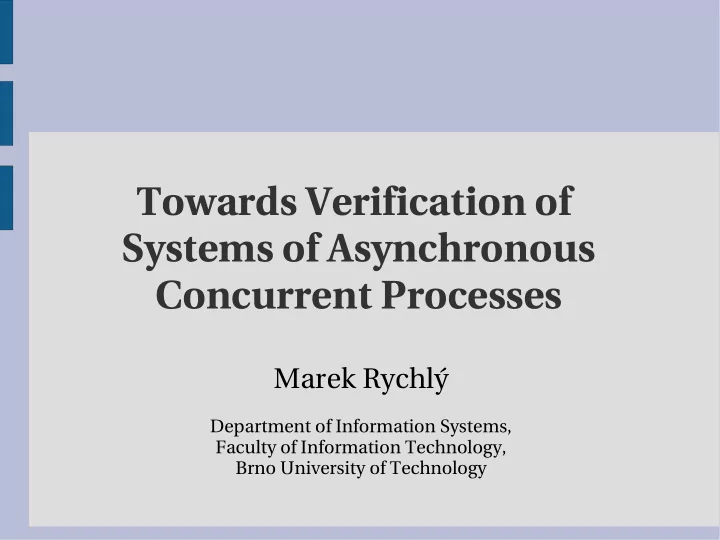

Towards Verification of Systems of Asynchronous Concurrent Processes Marek Rychlý Department of Information Systems, Faculty of Information Technology, Brno University of Technology
Outline ● Introduction ● Distributed information systems ● Asynchronous network model ● Process algebras (CCS, π -calculus, …) ● Modified asynchronous network model ● Framework for modified network model ● Formal specification ● Formal verification ● Future research ● References 2
Introduction ● What will be the presentation about? – a design method supported by a framework – distributed (networked) information systems – an asynchronous communication – a network of communicating processes – a specification of communication architecture ● What won't be the presentation about? – a logic of information systems – process specification – distributed algorithms 3
Distributed Information Systems ● Present-day information systems are built as SW confederations (peer-to-peer networks) ● Many autonomous components ● Gateways (interfaces) to a middle-ware ● Middle-ware provides dynamic connections – according to functionality (available services) – according to free resources – according to policies of components IS1 net IS4 IS2 IS3 4
Asynchronous network model ● directed graph of communicating processes ● edges are communicating channels ● two operations: – asynchronous send(m) i,j – synchronous receive(m) i,j ● many types of channels: – „universal reliable FIFO channel“ – „reliable reordering channel“ – „channel with failures“ (losses, duplications, …) 5
Asynchronous network model ● can be modelled as an I/O automaton – a labelled transition system model with output, internal and always enabled input actions and „a fair execution“ – developed by Lynch and Tuttle, 1987 6
Process algebras („process calculus“, „process theory“) ● algebraic approach to system of concurrent processes (high level of abstraction) ● formal verification – synchronization (critical sections) – liveliness, fair execution (deadlocks) – temporal logics (to describe properties of executions) ● Calculus of Communicating Systems (CCS) Milner, 80 th and 90 th years ● Communicating Sequential Processes (CSP) Hoare, 1984-85 7
π -calculus (calculus of mobile processes) ● R. Milner, J. Parrow a D. Walker (1992): A Calculus of Mobile Processes ● CCS with dynamic comm. structures ● only two concepts: – agent: communicating process, – name: comm. channel, variable, data, … ● key properties: – name passing – replication ● modifications: – polyadic, with replication, non-recursive, high- 8 order, with name equality, …
π -calculus: operations ● x<y>.P – operation „send“ ● x(y).P – operation „receive“ ● tau.P – internal (hidden) action ● (x)P – new name ● P|Q – parallel composition ● P+Q – non-deterministic choice ● A(x 1 ,…,x n ) – agent execution ● [x=y]P – name equality (extension) ● !P – replication (extension) 9
π -calculus: proofs ● Implementation of lambda-calculus (Robin Milner, 1992) ● Bisimulation equivalence: – early and late: input action after/before substitution (isn't congruent, Milner 1992) – open bisimulation: all actions (is congruent, Sangiorgy 1996) ● Proof of bisimulation equivalence in finite recursive π -calculus (Mads Dam, 1997) – auto-prover (Björn a Moller, 1994) The Mobility Workbench - A Tool for the π -Calculus 10
Modified asynchronous network model ● Original ANM: process and channel ● Decomposition of channel: – local interface ... „port“ – network buffer ... „link“ ● Translatable into original ANM P1 buffer P2 process port link port process 11
Framework for modified asynchronous network model ● Tool for modelling in Process modified network Atomic Composite model Process Process ● white-box framework Port of Port of (and implementation Atomic Composite library of components delegate for black-box fmw.) Port ● Hierarchy and notify attach/detach update observer Link encapsulation of processes 12
Formal specification ● High level of abstraction in the model – focused on the communication – unknown semantics of atomic processes ● Systems implemented using the framework are compatible with modified network model ● Systems implemented using the framework can be translated into π -calculus ● We suppose „universal reliable FIFO channel“ in formal specification (ideal) 13
Specification in π -calculus ● The atomic process is process of π -calculus ● The port is two channels (input and output) ● The link is expressed as π -calculus process, which connects input and output channels: ● The composite process is a parametric process (a parallel composition of its internal processes) with the ports of a composite process as its parameters 14
Formal verification ● After translation into π -calculus in MWB ● Problem with infinite recursion (replication) – Can be replaced with a finite number of concurrent processes? – Is it possible to use some recycling mechanism? ● We can: – prove weak and strong open bisimulation equiv. – find deadlocks – simulate and test system (as „a black-box“ and „a white-box“) 15
Future research ● Model: – Elimination of an infinite recursion – Influence of a network layer QoS on the model – Relation with UML2 (design pattern Port) ● Framework: – Lesser dependence on the network model – Framework implementation and case-studies – Specification of SOA, CORBA Event Service, … 16
References (1) Nancy A. Lynch. Distributed Algorithms . Morgan Kaufmann Publishers. San Francisco, CA, USA. 1996. (2) Robin Milner, Joachim Parrow, and David J. Walker. A calculus of mobile processes, I and II. Information and Computation , 100(1):1–40 and 41–77, 1992. (3) Victor Björn and Faron Moller. The Mobility Workbench — a tool for the π -calculus. In David Dill, editor, CAV'94: Computer Aided Verification , volume 818 of Lecture Notes in Computer Science , pages 428–440. Springer-Verlag, 1994. (4) Ugo Montanari and Marco Pistore. Finite state verification for the asynchronous π -calculus. In TACAS '99: Proceedings of the 5th International Conference on Tools and Algorithms for Construction and Analysis of Systems , pages 255–269, London, UK. Springer-Verlag, 1999. (5) Mads Dam. Proof systems for π -calculus logics. In R. de Queiroz, editor, Logic for Concurrency and Synchronisation , Trends in Logic, Studia Logica Library, pages 145–212. Kluwer, 2003. 17
Recommend
More recommend